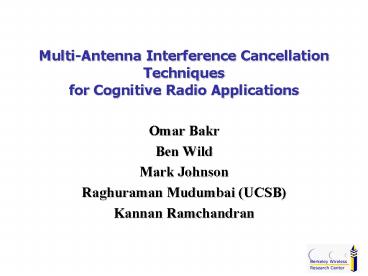MultiAntenna Interference Cancellation Techniques for Cognitive Radio Applications - PowerPoint PPT Presentation
1 / 13
Title:
MultiAntenna Interference Cancellation Techniques for Cognitive Radio Applications
Description:
hd is the channel response from SRt to SRr. Choose c to be the component of hd that is orthogonal to hj for 0 j K 1 (projection) ... – PowerPoint PPT presentation
Number of Views:201
Avg rating:3.0/5.0
Title: MultiAntenna Interference Cancellation Techniques for Cognitive Radio Applications
1
Multi-Antenna Interference Cancellation
Techniquesfor Cognitive Radio Applications
- Omar Bakr
- Ben Wild
- Mark Johnson
- Raghuraman Mudumbai (UCSB)
- Kannan Ramchandran
2
Last Time
- Improving spectrum reuse using primary and
secondary collaboration1 - More effective spatial reuse using multiple
antennas on the secondary - Example cellular uplink reuse
- Today signal processing and array processing
techniques to improve collaboration - To appear in IEEE WCNC 2009
1O. Bakr, M. Johnson, B. Wild, and K.
Ramchandran, A multi-antenna framework for
spectrum reuse based on primary-secondary
cooperation, in IEEE Symposium on New Frontiers
in Dynamic Spectrum Access Networks (DySPAN),
October 2008.
3
Benefits of collaboration
- Better primary control over interference levels
- Secondary systems are much easier to design and
operate - More consistent secondary access to the spectrum
- Primary systems can monetize spectrum usage
- Feedback from the primary allows more effective
use of multiple antennas for beamforming and
interference cancellation
Dual-Citizenship nodes
Primary Network
Secondary Network
4
Cellular uplink reuse framework
5
Collaborative framework for interference
cancellation
- hj for 0ltjltK1 are the channel responses from the
secondary transmitter (SRt) to each of K primary
users (base stations) respectively. - hd is the channel response from SRt to SRr.
- Choose c to be the component of hd that is
orthogonal to hj for 0ltjltK1 (projection) - Channels unknown apriori? Need to estimate.
6
Estimation using adaptive filtering
- Identifying an unknown filter (channel) H(z)
using an adaptive filter (e.g. Least Mean Square
(LMS) algorithm) - wn is a known pseudo random sequence, Gn(z) is
the local estimate - Gn(z) will converge to a noisy estimate of H(z)
(due to the presence of noise) - In the beamforming context, the taps of H(z) are
the complex responses from each antenna element
on the secondary radio towards a primary radio
7
Beam-nulling using adaptive filtering
8
Simulated interference rejection
22dB attenuation
Infinite phase/amplitude resolution
Finite phase/amplitude resolution
4 primary users (base stations), cognitive radio
has M antennas
9
Iterative channel estimation
- Less coordination among primary users
- Better reuse of allocated channels
- Same adaptive algorithm, different choice of
training sequence w - Adaptively perform a Gram-Schmidt
orthogonalization - Start with the closest node (e.g. PR1)
- Run LMS at low power (no interference to other
nodes) - After estimating h1, increase the power and
choose w orthogonal to h1 - This will estimate the component of h2 orthogonal
to h1 - Increase the power, choose w orthogonal to both
h1, h2
10
Simulated interference rejection
22dB attenuation
Infinite phase/amplitude resolution
Finite phase/amplitude resolution
4 primary users (base stations), cognitive radio
has 12 antennas
11
What about the receiver
12
Interference suppression framework
- Primary transmitters (cell phones) can cause
interference to the secondary (cognitive radio)
network - At the secondary receiver
- yn hddn ?i hidin ?n
- Choose beamforming (spatial filter) to maximize
SINR - SINRoutchhd2/(?i chhd2 N?)
- MMSE criterion
- cMMSE arg minc en2 arg minc chyn -
dn2 - Good rejection in slow fading channels
- Doppler/frequency offsets can create problems
13
Differential MMSE Framework2
- Even in fast fading environments, channel remains
relatively constant over successive symbols - Avoid tracking channel variations by only looking
at the difference (ratio) between symbols
(similar to differential modulation) - DMMSE criterion
- cDMMSE arg minc chyn-1dn - chyndn-1
2 - Subject to Echyn21
2U. Madhow, K. Bruvold, and L. J. Zhu,
Differential MMSE A framework for robust
adaptive interference suppression for ds-cdma
over fading channels, IEEE Transactions on
Communications, vol. 53, no. 8, pp. 13771390,
Aug. 2005.
14
Simulated interference rejection
DMMSE, offset10 symbol rate
NLMS, offset1 symbol rate
8 antennas, 6 interferers, SNRin-20dB,
SIRin-40dB

